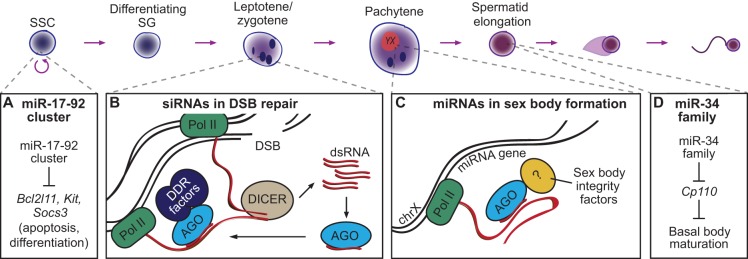Fig. 3.
Potential roles for AGO-bound small RNAs during spermatogenesis. (A) There is evidence to suggest that the miR-17-92 miRNA cluster is important for maintenance of spermatogonia in an undifferentiated state. (B) Observations in somatic cells suggest that AGO-bound small RNAs in the nucleus help repair DSBs, which are introduced to facilitate synapsis during leptotene. In such a model, divergent transcription from sites of DSBs produces dsRNA, which is cleaved by DICER and loaded onto AGO proteins. AGO proteins can then be guided back to these sites via base pairing between DSB-associated small RNAs and precursor transcripts, where they can recruit DNA damage response (DDR) factors. (C) During pachytene, AGO-bound small RNAs are important for proper sex body formation. In the model shown here, miRNA-encoding genes that escape silencing on the X chromosome produce miRNAs that are loaded onto AGO proteins. AGO proteins are then guided back to their locus of origin via base pairing between miRNAs and precursor transcripts. AGO proteins recruit unknown sex body integrity factors to form the sex body's tertiary chromatin structure, in which miRNA loci are localized to the periphery and escape silencing. (D) The miR-34 family is essential during pachytene, and also for spermatid elongation, for which it is hypothesized to play a role in basal body maturation and hence spermatid flagellum formation.

